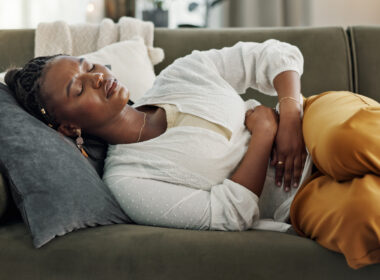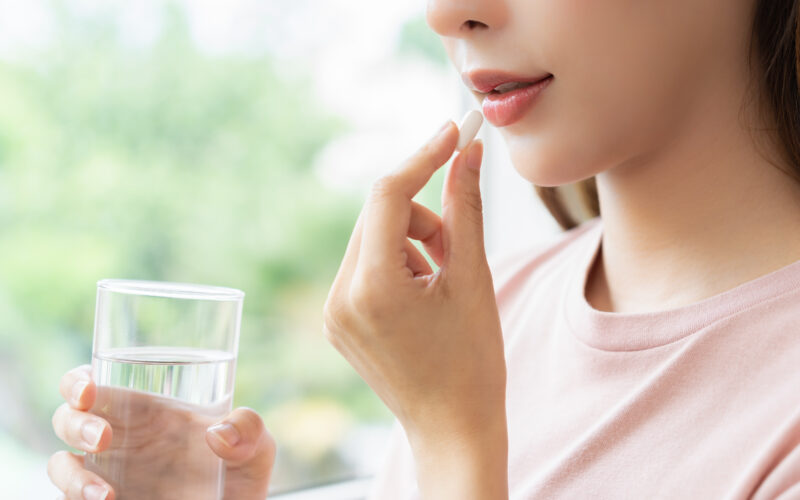“Why haven’t I heard of this?!” That was my response when my doctor suggested taking Low Dose Naltrexone (LDN) and explained its many potential benefits for fertility and hormonal-related conditions.
Naltrexone, a medication with a fascinating history, was originally prescribed to treat opioid addiction. It’s since been shown to be a promising therapy for a wide range of conditions—including hormonal disorders. Furthermore, some providers trained in restorative reproductive medicine report it to be beneficial at much lower dosages as an adjunct (additional, not standalone) treatment for hormonal imbalances. Here, we delve into LDN’s history, how it works, and its demonstrated benefits for women’s health.
A primer on Low Dose Naltrexone
LDN (more on the “low dose” in Low Dose Naltrexone below!) has been utilized as part of an overall treatment plan for a variety of fertility and autoimmune conditions, including:
- Premenstrual symptoms (PMS)
- Endometriosis
- Polycystic Ovary Syndrome (PCOS)
- Dysmenorrhea (painful periods)
- Persistent brown menstrual bleeding
- Persistent fatigue, sleep disturbances, low mood, excessive anxiety
- Autoimmune conditions such as multiple sclerosis, rheumatoid arthritis, insulin-dependent diabetes, and underactive thyroid
- Crohn’s disease
- Cancer [1]
The strongest evidence to date appears to be for LDN’s effectiveness in treating multiple sclerosis, Crohn’s disease, and fibromyalgia [2][3][4].
History of naltrexone: From addiction medicine to seemingly limitless potential
Developed in the 1960s, naltrexone was originally designed to block the effects of opioids. Approved by the FDA in 1984, it works by binding to opioid receptors in the brain, preventing substances like heroin and morphine from producing their euphoric effects [5]. It became a cornerstone of addiction medicine, offering hope to those battling substance use disorders [6].
Over time, research expanded beyond addiction treatment, revealing naltrexone’s potential to address conditions linked to high endogenous (the body’s own) opioid levels, including hormonal imbalances and immune-related disorders.
Naltrexone’s role in hormonal health
Naltrexone has been studied as an adjunct treatment for hormonal disorders for several decades. In the early 2000s, a study examined the combination of 50 mg naltrexone with pulsatile gonadotropin-releasing hormone (GnRH) to stimulate ovulation and pregnancy in women with polycystic ovary syndrome (PCOS). 90% of women treated with both GnRH plus naltrexone successfully ovulated, compared to 60% of those receiving GnRH alone [7].
Notably, the combination treatment group also exhibited a reduced insulin response to an oral glucose tolerance test, lower luteinizing hormone (LH) levels, and a larger dominant follicle diameter. These findings suggest that naltrexone enhances ovarian responsiveness to ovulation induction beyond the effects of pulsatile GnRH alone.
A surprising discovery: immune system benefits at low doses
Alongside developments for the use of high dose naltrexone, in the 1980s, HIV researcher Dr. Bernard Bihari observed unexpected immune-boosting effects when his patients took naltrexone in smaller doses. This discovery sparked further research into naltrexone’s ability to modulate the immune system at low doses, and by the early 2000’s “low dose naltrexone” (LDN) was increasingly explored for treating autoimmune conditions.
Today, the LDN Research Trust lists over 100 conditions for which LDN shows promise, including heart disease, chronic pain, endocrine diseases, and women’s health conditions. Despite more than 11,000 published research papers on naltrexone, most focus on high-dose applications. Because LDN is not yet FDA-approved, few large-scale randomized controlled trials have been conducted. However, its growing clinical use suggests significant therapeutic potential.
Dr. Phil Boyle: A pioneer for use of LDN to help couples successfully achieve pregnancy
Although research on low-dose naltrexone for infertility, PMS, and miscarriage remains limited, Dr. Phil Boyle, founder of NeoFertility in Dublin, Ireland, has emerged as a leading expert in this area. Since 2002, he has incorporated LDN into fertility treatments for women with symptoms of clinical endorphin deficiency—often linked to PMS, fatigue, endometriosis, and PCOS.
Dr. Boyle has safely treated over 2,000 pregnancies with LDN until 37 weeks of gestation, and has helped over 4,000 couples achieve successful pregnancies— some after years of infertility, recurrent miscarriage, and even after multiple failed rounds of IVF. His extensive clinical experience and research have paved the way for more restorative reproductive medicine doctors to adopt LDN as a tool for improving fertility and preventing miscarriage.
Mechanism of action: How does LDN work?
At low doses (1.5 to 4.5 milligrams, compared to the standard 50 milligrams for addiction treatment), naltrexone exhibits anti-inflammatory and immune-modulating properties.
LDN’s effects, summarized from the sources cited throughout this article, stem from its ability to:
- Modulate the Immune System: LDN regulates overactive immune responses, reducing inflammatory chemicals such as cytokines and interleukins.
- Boost Endorphin Production: By temporarily blocking opioid receptors, LDN stimulates the body to produce more endorphins. These “feel-good” chemicals improve mood and play a role in immune and hormonal regulation.
- Reduce Inflammation: Chronic inflammation is a common thread in many hormonal disorders. LDN’s anti-inflammatory properties help mitigate this underlying factor.
Female hormonal conditions that may benefit from LDN
Polycystic Ovary Syndrome (PCOS)
LDN may improve insulin sensitivity and reduce chronic inflammation, addressing two root causes of PCOS. It can alleviate symptoms such as irregular periods, acne, and weight gain.
Endometriosis
Clinical experience and anecdotal evidence suggest LDN can reduce inflammation and pain associated with endometriosis (without the side effects of hormonal birth control). Dr. Phil Boyle reports that approximately 80% of his patients experience significant pain relief with nightly LDN use.
Thyroid disorders
Clinicians and patients report improvement of autoimmune thyroid conditions like Hashimoto’s thyroiditis through use of LDN. While LDN may not successfully improve autoimmune and thyroid conditions for everyone, it is a treatment option that could provide significant benefits for some. Isabelle Wentz, a pharmacist who specializes in Hashimoto’s, surveyed 2,000 individuals suffering from Hashimoto’s. 38% reported that LDN improved their symptoms. Of these 38%, “Forty-eight percent were able to reduce their thyroid antibodies, 61 percent saw an improvement in mood, 66 percent had more energy, and 40 percent saw a reduction in pain.”
Menstrual irregularities and perimenopause
For women experiencing irregular cycles or hormonal shifts during perimenopause, LDN may help stabilize hormone levels and alleviate symptoms such as mood swings, fatigue, and joint pain.
One study in the 1990s of 25 mg of naltrexone (note that this wouldn’t technically constitute low-dose naltrexone, which is prescribed in dosages from 1.5 to 4.5 mg) given to women experiencing hypothalamic amenorrhea demonstrated that 80% of participants saw a return of menses within 90 days [8].
Additionally, average estradiol levels increased significantly in all patients after 3 and 6 months of treatment with naltrexone, suggesting a relationship between the opioid system and the hypothalamic-pituitary-gonadal axis. This research also highlighted the potential for naltrexone to treat amenorrhea when combined with weight gain (for underweight individuals).
Premenstrual syndrome (PMS)
Endorphin deficiency has been linked to PMS symptoms like mood dysregulation and breast tenderness [9]. Small studies and anecdotal reports suggest LDN can significantly reduce these symptoms by boosting endorphin levels [10][11]. Theresa Kenney, NP, co-host of the Hormone Genius Podcast, has found that her female patients often report feeling more stable, handling stress better, and no longer experiencing emotions that are “all over the place” after taking LDN for PMS symptoms.
Why isn’t LDN more commonly used?
LDN is considered an “off-label” treatment for the conditions listed above, meaning its use for inflammatory and hormonal conditions is not yet FDA-approved. This lack of approval has limited widespread adoption and research, as it isn’t actively promoted by pharmaceutical companies. As a result, many doctors default to prescribing hormonal contraceptives or NSAIDs like ibuprofen or Motrin for conditions like painful periods.
It’s worth noting that many pharmaceutical drugs have “off-label” uses. In other words, lack of FDA approval does not necessarily mean a medication is ineffective in treating a condition or unsafe to take. Of note, the prescription of hormonal birth control for the treatment of acne, PMS, and other cycle-related symptoms are off-label uses of the pill.
Are there concerns about using LDN?
LDN enhances the body’s natural healing processes but is not a standalone solution. It’s essential to work with a knowledgeable doctor to determine the right dosage and monitor progress. Typical side effects are minimal but can include vivid dreams, nausea, headaches, and disturbed sleep. Importantly, LDN cannot be mixed with narcotics and/or alcohol.
LDN should be part of an overall treatment plan that includes lifestyle changes to reduce inflammation, such as:
- Following an anti-inflammatory diet (e.g., reducing processed sugars, grains, and dairy)
- Incorporating supplements like vitamin D and omega-3s
- Prioritizing stress management, sleep, and regular exercise
Charting the ovulatory cycle using a fertility awareness method is an excellent first step in identifying, diagnosing, and addressing cycle-related conditions that LDN may effectively treat.
The bottom line on low-dose naltrexone for PMS, endo, PCOS, and more
Low-dose Naltrexone represents an exciting frontier in managing hormonal conditions. By addressing inflammation and modulating the immune system, it offers hope for women facing challenges like PCOS, endometriosis, and thyroid disorders. As awareness grows, LDN may have the potential to transform women’s health, empowering women to take control of their well-being. If you experience any of the symptoms discussed in this article, consider speaking to your doctor about LDN. Be prepared to educate and advocate for yourself, as many physicians may not be familiar with its applications.
If you want to learn more about low-dose Naltrexone, check out the LDN Research Trust website, this episode of the Hormone Genius podcast Hormone Genius Podcast: Low Dose Naltrexone, these presentations by Dr. Phil Boyle Dr. Phil Boyle: LDN for Women’s Health and Dr. Phil Boyle: LDN for PMS & PMDD, and this episode of the Gut Check podcast Gut Check Podcast: LDN Unlocked.







